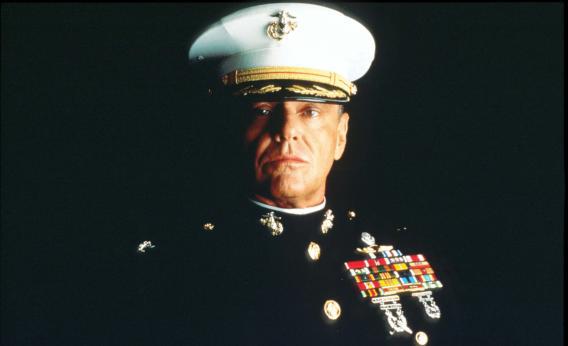In an insightful piece for Grantland yesterday, Sean Fennessey bemoaned the death of the legal thriller, waxing nostalgic for Grisham hits of yore like The Firm, The Rainmaker, and The Pelican Brief. Fennessey is mostly on point: Apart from a few recent exceptions—he rightly mentions ’07’s masterful Michael Clayton—Hollywood has abandoned its legal thriller heyday and devoted all blockbuster resources to superhero tentpoles, sci-fi fantasies, and the occasional disaster flick. And that’s too bad: It’d be nice to have big-budget entertainment that dealt with real, unmutated human beings (and as far as capeless movie heroes go, Tom Cruise in a fitted suit is usually a fair bet).
But later in the piece, Fennessey makes another bold claim about the legal thriller’s close relative, the courtroom drama. Noting the success of A Few Good Men, he writes:
A Few Good Men isn’t quite a legal thriller. It concerns legality and it thrills. But it’s really just a courtroom drama, a procedural story that maps a conviction or acquittal, or perhaps unravels a civil case that awards millions to a victimized group of people. Courtroom dramas are as old as Mickey Rooney and they’re still being made today. Inherit the Wind has been adapted four times; 12 Angry Men at least three. The Verdict lives forever; Witness for the Prosecution is unimpeachable. These movies are timeless, lauded, and limiting. But legal thrillers, and their legacy, have vanished.
He’s right to distinguish between courtroom dramas and legal thrillers. But he’s wrong by a long shot about their current status. The courtroom drama is even more endangered than its sexier cousin, and it doesn’t look like it’ll be rescued any time soon. Production companies’ boorish and lamentable refusal to back movies that don’t feature superheroics has dimmed the legacy of all law films, not just the thrillers that used to do so well at the box office.
In the 1950s and ’60s, the courtroom drama was arguably the Hollywood genre. Besides the three examples Fennessey mentions (The Verdict, from 1982, is the product of a later era), the period produced Anatomy of a Murder (1959), I Want to Live! (1958), To Kill a Mockingbird (1962), and Judgment at Nuremburg (1961). In a five-year span these seven movies garnered 22 Oscar nominations for Best Picture, Director, Actor, and Screenplay. Trial films were commercial and critical juggernauts.
Times have changed. In the 21st century, only five law-related films have been nominated at the Academy Awards: The Insider, Erin Brockovich, Michael Clayton, Chicago, and The Reader. The first three are more legal thrillers than courtroom dramas; the latter two don’t really fit into either category, but merely incorporate trial procedure to some extent. Fennessey cites the multiple adaptations of courtroom drama films as evidence that they’re thriving. In fact, the reliance on remakes hints at the depressing state of a genre that has begun to feel archaic. In the case of Inherit the Wind, for instance, three mediocre television adaptations isn’t exactly cause for celebration.
The courtroom drama has been subjected to some misguided genre mixing, as in 2005’s The Exorcism of Emily Rose, which bizarrely used a trial as the framing device for, you guessed it, an exorcism. But even the comical takes that were big hits not that long ago—My Cousin Vinny and Legally Blonde, for example—have stopped getting made, and a movie like The Lincoln Lawyer, which Fennessey correctly praises, is an exception to the rule. The law film—whether legal thriller or courtroom drama—may make an occasional appearance, but its death sentence, issued some time ago by Hollywood executives, has clearly been passed. You’re more likely to find celebrity-centered courtroom drama outside the silver screen than on it.
